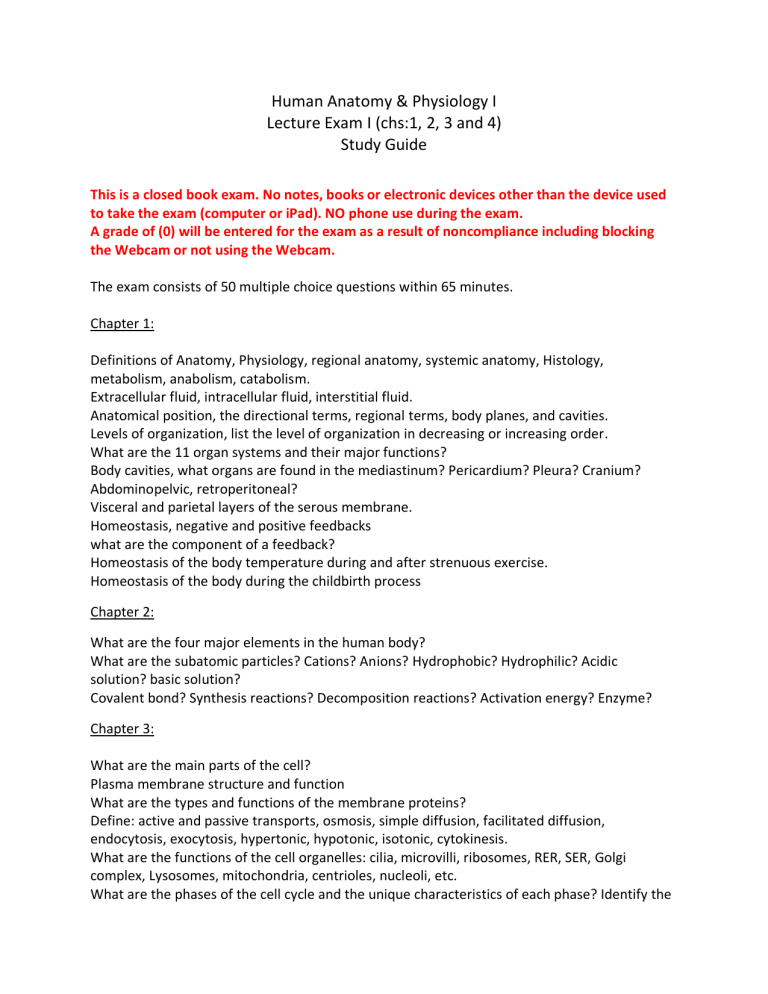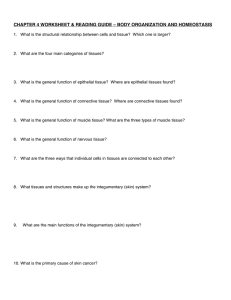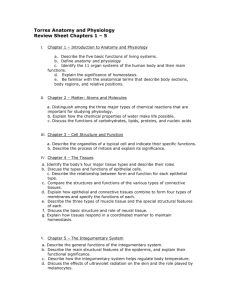
Human Anatomy & Physiology I Lecture Exam I (chs:1, 2, 3 and 4) Study Guide This is a closed book exam. No notes, books or electronic devices other than the device used to take the exam (computer or iPad). NO phone use during the exam. A grade of (0) will be entered for the exam as a result of noncompliance including blocking the Webcam or not using the Webcam. The exam consists of 50 multiple choice questions within 65 minutes. Chapter 1: Definitions of Anatomy, Physiology, regional anatomy, systemic anatomy, Histology, metabolism, anabolism, catabolism. Extracellular fluid, intracellular fluid, interstitial fluid. Anatomical position, the directional terms, regional terms, body planes, and cavities. Levels of organization, list the level of organization in decreasing or increasing order. What are the 11 organ systems and their major functions? Body cavities, what organs are found in the mediastinum? Pericardium? Pleura? Cranium? Abdominopelvic, retroperitoneal? Visceral and parietal layers of the serous membrane. Homeostasis, negative and positive feedbacks what are the component of a feedback? Homeostasis of the body temperature during and after strenuous exercise. Homeostasis of the body during the childbirth process Chapter 2: What are the four major elements in the human body? What are the subatomic particles? Cations? Anions? Hydrophobic? Hydrophilic? Acidic solution? basic solution? Covalent bond? Synthesis reactions? Decomposition reactions? Activation energy? Enzyme? Chapter 3: What are the main parts of the cell? Plasma membrane structure and function What are the types and functions of the membrane proteins? Define: active and passive transports, osmosis, simple diffusion, facilitated diffusion, endocytosis, exocytosis, hypertonic, hypotonic, isotonic, cytokinesis. What are the functions of the cell organelles: cilia, microvilli, ribosomes, RER, SER, Golgi complex, Lysosomes, mitochondria, centrioles, nucleoli, etc. What are the phases of the cell cycle and the unique characteristics of each phase? Identify the graphic phases of mitosis. What are the major differences between mitosis and meiosis? Chapter 4: You may be asked to identify graphic tissues and their functions or locations, likely the ones mentioned during the video presentation. What are the characteristics of epithelial tissues? connective tissues? muscular tissues? nervous tissues? What are the functions of epithelial tissues? Connective tissues? What is the difference between exocrine and endocrine glands? What are the secretions of the glands? What are the three types of fibers in the human body? Which type is the most abundant? Cell junctions and their functions? What are the cells that found in each of the following mature connective tissues? (bone, cartilage, blood) What are the cells that can be found in the connective tissue proper? What are the types of membranes and their locations? What are the characteristics of each type of muscle tissues? I know you can do it GOOD LUCK






